Most crocheters learn early on how to create single and double crochet stitches. And eventually, you might have tackled a treble crochet stitch! But did you know it doesn't end there? You can keep adding yarn overs as long as you can fit them on the hook! Here's the how to and names for the *really* tall crochet stitches!
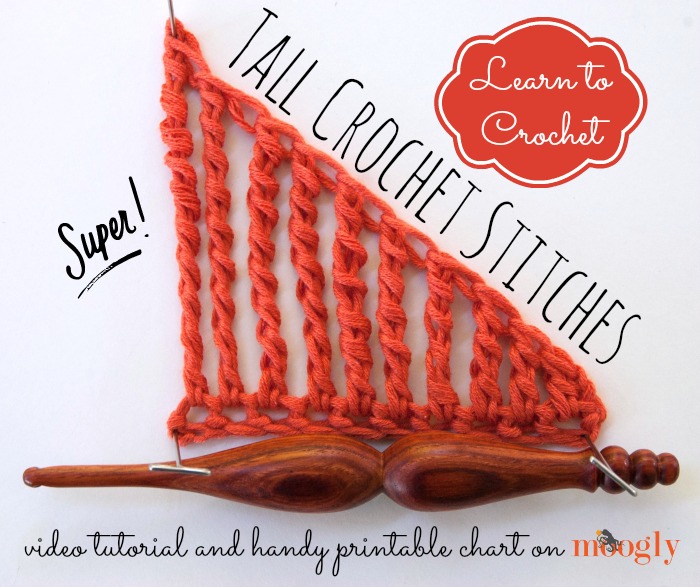
Disclaimer: This post contains affiliate links.
Tall Crochet Stitches Video Tutorial
As Seen In This Video (click to order)
If you understand the anatomy of a double crochet and a treble crochet, then it's easy to extrapolate what to do when you see a taller stitch - just add yarn overs at the beginning, and then work the loops off in twos. Easy!
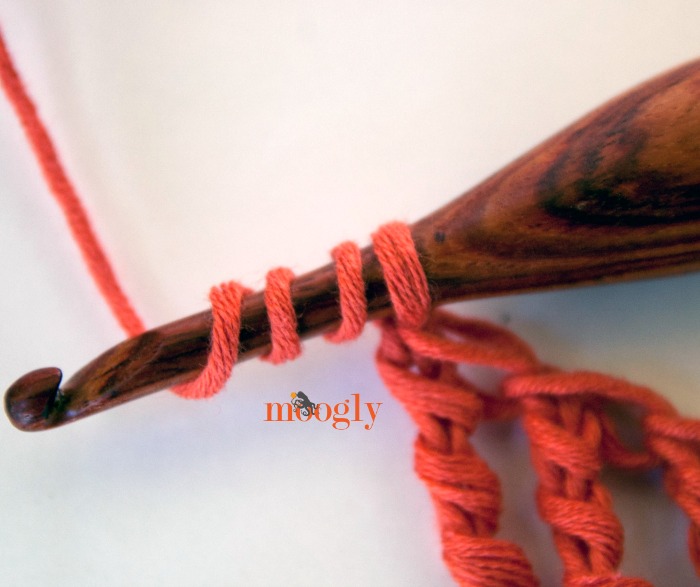
But the names can be super confusing! Most of us don't talk in "quintuple" this and "septuple" that. Add treble to the name and it can be a head scratcher. Here's a chart to make it easier!
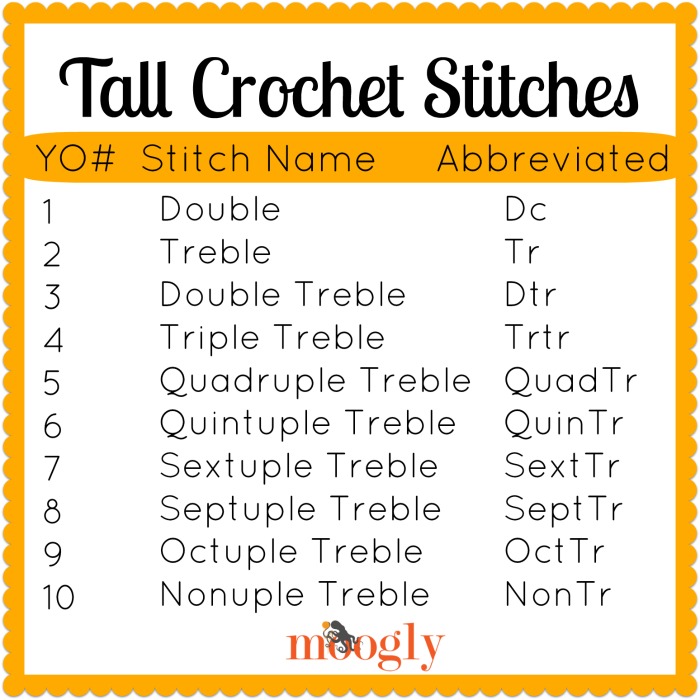
You might want to Pin the chart on Pinterest, or print it out (use the Print Friendly button below to print just the chart!). I know I have to check the list sometimes myself! The abbreviations past trtr can vary, but they should be close to the ones given above.
There's a trick I use to help myself remember them too. Double and Treble are easy enough to remember, but past that is where it gets heavy. What I do is count the "treble" as a 1, and then take the preceeding word at face value, and them add them together. So for a Quadruple Treble, I count the quadruple as 4 (it's usual meaning) and add 1 for the treble... for 5 yarn overs. For Septuple Treble, I take the 7 of Septuple and add one more for the Treble... 8 yarn overs!
One of the hardest parts of actually making these tall stitches is working the loops off evenly. And the other hard part is keeping the twist in the yarn - most yarns are twisted so that crochet stitches untwist it a bit, and these tall stitches can do a number on it! Relaxing your tension on the yarn can help, as can blocking the project afterwards. Most of the really tall stitches will show up in lace patterns, so blocking will be important anyway! Notice the pins in the photo - blocking for the win!
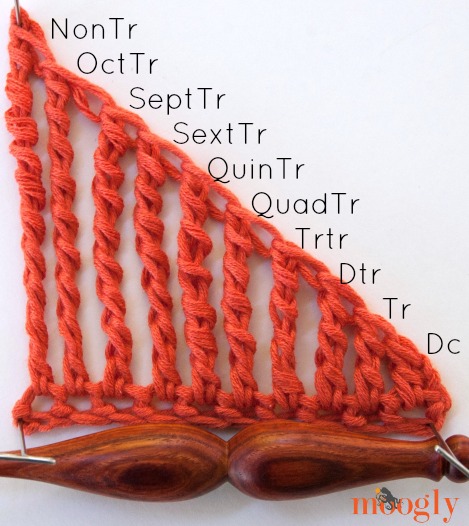
Now, you won't see many of these stitches too often - generally speaking, the taller the stitch, the less common it is. You could easily go an entire crochet career without ever making a Nonuple Treble Crochet - I think most have! But now you know what to do if you do see one. And you can tackle that gorgeous lace pattern that calls for Triple Treble and Quadruple Trebles with confidence!
Thanks so much for watching! Don't forget to subscribe to the Moogly YouTube channel, and get more Moogly goodness on Facebook, Twitter, G+, Pinterest, Tumblr, and sign up for the Newsletter so you don’t miss a thing!


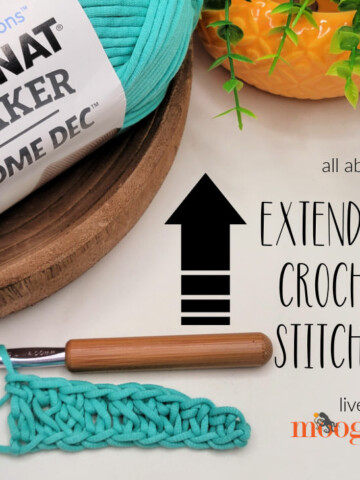
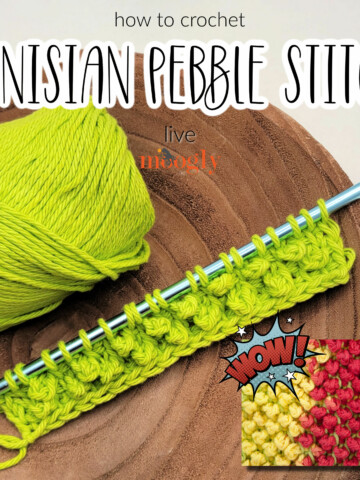
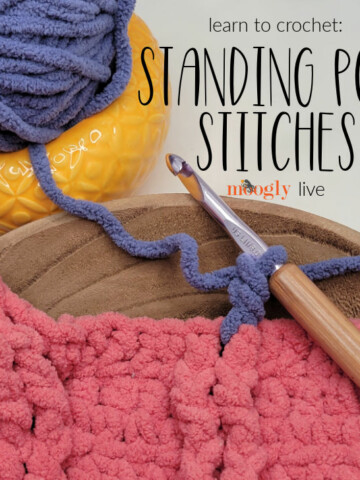


Annette
Thank you for taking the time to do this !! I love, love, love this yarn.
Nancy
Thank you soooo much for this stitch chart. Just a few days age o on a site someone had never heard of the treble stitches. I hope they see this. And your tutorial is very good and easy to follow. Nancy
Tamara Kelly
😀 Thank you so much Nancy! I hope it helps lots of people!
Paula
And of course, check where your pattern comes from, as UK trebles are US doubles, and UK double trebles are US trebles, and after that.... well, read the pattern carefully for the stitch descriptions!
Tamara Kelly
Yes! I'm imagining there's an interest in a UK chart maybe? But that might break my brain to do both the same day lol.
Dianna
I recently had to go to a forum asking for help. A Venetian Motif chart pattern I was trying to figure out had the symbol for a sextuplets treble. I had never seen one before! Not easy to do and keep consistent either. I know what they are now, but I didn't know what the names are. Thanks!
Tamara Kelly
😀 They are rare - it's fun to hear of them spotted in real patterns! I'm sure I'd have to pull out and re-do my fair share!
Verna Pasquariello
Could you please tell me the color wood of the Furl's crochet hook? I'm thinking of trying one, but can't decide between the Rosewood or the Cocobolo. Also, any recommendation for size to buy if purchasing only 1? I was thinking of 'G'.
Thanks!
Tamara Kelly
Hi Verna! The one I used here is a Tulipwood. I also have a Cocobolo and a Purpleheart and they're all lovely! I would recommend buying whatever hook size you use most first - that will be different for everyone. I track all my projects on Ravelry so I was able to go back and look at what hook I'd used most. 🙂 I got an I first, as that's what I use most it seems, then added an H and a J - working my way out! 😀
DIANE
THANK YOU SO MUCH FOR THIS INFO . . . AND A QUESTION PLEASE.
IF I ENDED A ROW WITH A NON TREBLE, WOULD I CHAIN UP 11 STITCHES TO EQUAL THE HEIGHT?
Tamara Kelly
That will depend a bit on gauge - the more stitches, the more you'll want to customize - but 11 or 12 should be right!
Snowcatcher
Thank you for doing this! I've often used what I called "mega trebles" in my patterns and used the number of times to yarn over because I didn't know they had names beyond quin. This is one handy dandy chart, and I appreciate you taking the time to make it!
Tamara Kelly
😀 Thank you so much! The yarn overs are really what it's all about anyway 😉
Stella Altman
This is just for fun. I seriously doubt anyone would want to go much higher than the chart above:
1 - single . (singleton / monuple)
2 - double . (couple / (ordered) pair / dual / twin / product)
3 - triple . (treble / triplet / triad)
4 - quadruple .
5 - quintuple .
6 - sextuple .
7 - septuple .
8 - octuple .
9 - nonuple .
10 - decuple .
11 - undecuple .
12 - duodecuple .
13 - tredecuple .
14 - quattuordecuple .
15 - quindecuple .
16 - sexdecuple .
17 - septendecuple .
18 - octodecuple .
19 - novemdecuple .
20 - vigintuple .
Tamara Kelly
That's gonna be a looooooong stitch ahahah! (And might require a Tunisian hook to pull off!)
Ada
love it! I did 20-vigintuple wondering what I would made of it Lol.
Tamara Kelly
Oh my!!!!
LINDA BLANKENSHIP
very nice and ty very much for the help
Tamara Kelly
😀 Thank you Linda!
Lorene Horton
I taught myself to crochet and I never knew there was that many tall crochet stitches. Thank you so very much. Now I just have to figure out what you can make with the tall stitches. Thanks again. If you have any ideas that I can do with the long stitches please let me know.
Tamara Kelly
Hi Lorene! They're mostly used for doilies and other fine thread lacework - you don't see them too often using heavier yarn! Though I do think some of the overlay mandalas might be bringing them into vogue too! I'll soon have a pattern out using a tall one too! 🙂
Nadine
This is so awesome! My grandmother was teaching me this when she passed away so many years ago. It is so great that I get to see it now, 40 years later! Thanks for sharing and bringing back such wonderful memories for me!
Tamara Kelly
<3 Thank you Nadine, what a wonderful memory to have!
Ruth
Thank you for explaining these stitches.
Tamara Kelly
🙂 You're very welcome!
Cathy matthews
This site has been so helpful. I know a lot of the longer stitches but it is so nice to have a reference for the rest of them. Thank you. CathyJ248
Tamara Kelly
Thank you so much Cathy, I'm glad to hear it!
Pallie
This shows the stitches and how they are done very well. I was wondering if you could also show what the symbols for these stitches would look like in a chart. I would also like to see the symbols for the long stitches if you could get them for us. Thanks, Pallie
Tamara Kelly
Ah, good idea Pallie, thank you!
Lindsey
Thank you for this tutorial! Maybe you can help me with an issue I've been having. It seems, that the taller my stitch (or if I have to crochet across a gap where I skip a few stitches), the longer the last loop on my hook becomes as I work the stitch. The rest of my stitch looks fine, but the very top of the stitch seems stretched out or long. Do you have any suggestions on how to combat that? Thanks for all you do!
Tamara Kelly
Thank you so much Lindsey! This is a very common problem! If it's a long chain then skip sts situation, the key is really just to consciously keep tight tension on that last chain as you work the next stitch. For the tall stitches, it helps to keep the wraps tight on the hook, and use your non-hook hand to pinch the pairs of loops as they come off the hook. Then, scooch the excess yarn down into the rest of the stitch by tugging on the loose loops on the right, working your way down the stitch - sort of as if you were adjusting tension on bootlaces, to make it even.
Lindsey
Thank you so much, Tamara! I know you addressed the problem a bit in your video, but it really helped to be able to read your response. I really noticed the problem when working on the first block of this year's CAL. Luckily, those long tops are hidden and actually in that particular instance made it a bit easier to see where my next row of crochet needed to go. 🙂 Thank you for such a quick and helpful response!
Cgurl
Wow, my eyes have been opened! I have only done up to a treble crochet, but how cool to find out there are stitches where you can add more onto the hook. (Ya, I am not a seasoned hooker yet).
I stumbled onto this page after reading about your crochet braid loops...and omg, have to thank you for that tutorial...I have been driving myself crazy trying to learn cable crochet to embellish a headband with some success, but the whole fptc and bptc are well... tedious, so having this easy method to do something pretty is a godsend (no more pulling my hair out, lol)
Tamara Kelly
😀 I'm so glad you like them Cgurl!
rose
How do I worksideways on the fingerlessmitts? I don't understand. Thanks!
Tamara Kelly
Hi Rose! Can you tell me what pattern you're referring to?
Nancy Ferrell
IM MAKING THE UP & DOWN SLOUCHY HAT BUT MY QUAD TREBLE STITCHES ARE LONG AND YOUR HAT DOESNT SHOW ANY LONG STITCHES. SO, IM VERY CONFUSED. HAVE I DONE SOMETHING WRONG? I LOVE THESE TUTORIALS AND LEARNING ALL OF THESE NEW STITCHES ! AWESOME ! TY.
Tamara Kelly
Hi Nancy! If you look at the Ups and Downs Hat pattern, and scroll down a bit, you'll see that the quad tr sts are used to create the braid. There is a video tutorial for that portion as well. 🙂
Nancy
Thanks
Nancy
I finished the Slouch hat but I want to make the one in the main picture. Can you give me the pattern or tell me wher to find it. I've looked but can't find it.
Nancy
Tamara Kelly
Hi Nancy! I'm guessing you mean the Ups and Downs Slouchy Beanie? Did you braid the quad tr sts? There's a tutorial on how to do that HERE as well as instructions at the bottom of the pattern.
Elizabeth Snelling
Thank you so much for the chart I have been crocheting along time but I have never heard of this stitches before I have done the double, treble, but other then that I have not done none of them so thank you so much now I will know what they mean if I ever come across them in a pattern.
Thank you
Elizabeth Snelling
Tamara Kelly
😀 So glad you like it Elizabeth, thank you!
To Tak Fun
Great tips. Thank you.
I am learning to do the blossom stitch with triple crochet but after turning for the second row,the triples don’t look like those in the first row so my blossoms look weird because the front and back of a triple crochet do not look the same.
I have searched for an explanation but can’t find any. Please help me fix this. Thank you in advance.
Tamara Kelly
Thank you so much!
I'm not familiar with that stitch pattern specifically, but the two sides of the stitches are indeed different. If you don't like the way the backs of the stitches look within a stitch pattern, I would recommend using it only to work in the round, or putting another row in between the rows where you do use it, so that you only make the trebles from the Right Side of the fabric. 🙂
Stella Altman
If you could tell me the name of your pattern and how to find it, I would love to try it myself.
Valerie
I am rather upset right now. I wanted to print out the above chart and it says to use the "print friendly" button below which I did. It did not indicate that I would end up printing the whole article and ALL OF THE COMMENTS. What a waste of ink! 19 PAGES TOTAL. Thanks Moogly.
Tamara Kelly
Hi Valerie! I'm sorry you had a bad experience with Print Friendly. Like any app, it can take some getting used to. If you'd like to print just a portion of a post, all you have to do is click on the parts you don't want before you click on the Print button. There's a tutorial here if you need more help: https://www.mooglyblog.com/print-pattern-use-print-friendly-button-moogly/